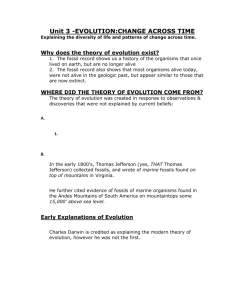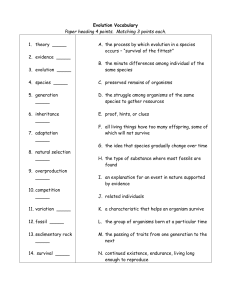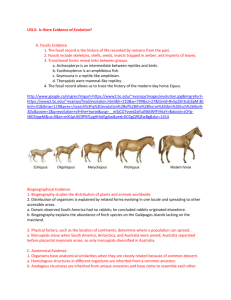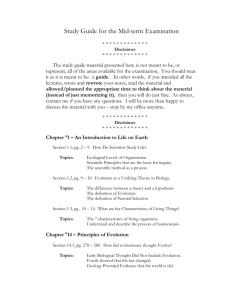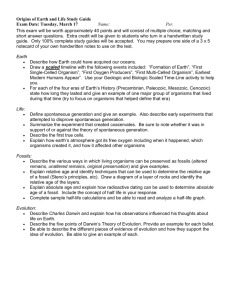Human Evolution
advertisement
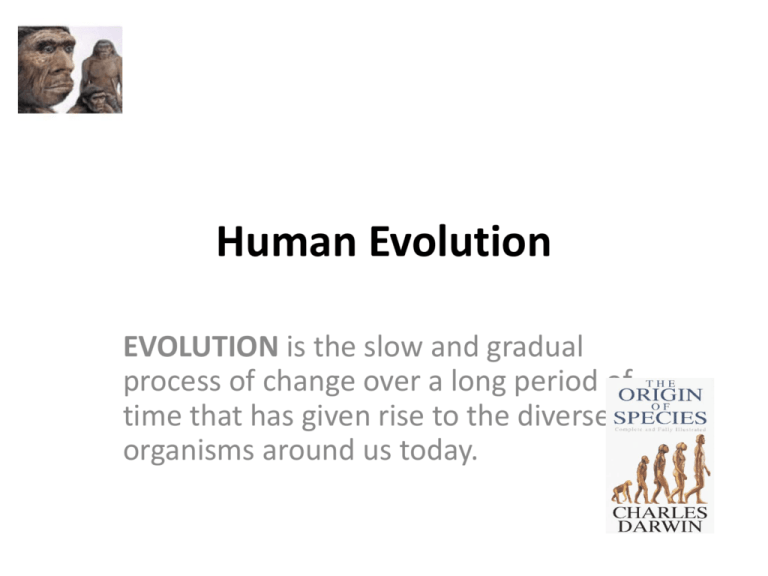
Human Evolution EVOLUTION is the slow and gradual process of change over a long period of time that has given rise to the diverse organisms around us today. • Anthropology • Archeology • Paleontology Which picture represents each field of study? Becoming Human • The Human Story • http://www.becominghuman.org/node/intera ctive-documentary • The fossil record • http://www.becominghuman.org/node/intera ctive-documentary What do we share in common with other hominins? • http://www.becominghuman.org/node/intera ctive-documentary • Australopithecus – bipedalism, use of hand and feet • Homo species- skeletal structure has developed to be larger, larger brain, carnivores Adaptation • Structural, physiological or behavioral characteristic that enhances the ability of the organism to cope with its prevailing environment. • In the case of humans adaptation to bipedalism led to many other adaptations that effected many aspects of the way they survived in their environment e.g. the way they searched for food, tools to bulid shelter, sexual practices…. Variation The changes within a population. Give an adaptation you were looking at in the hominin prac assignment. What variations in this adaptation did you find? Comparison of skulls CHIMPANZEE GORILLA HUMAN SKULL Similarities Between Apes and Humans – Opposable thumb ability to use tools – Share common genes, closest relative is the chimpanzee – Eyes in front of the head – Position of foramen magnum fairly low allowing to stand upright – Face flatter than most other animals – Similar dental structure with canines – Molar teeth used for grinding food Unique Features of a Human Skull • Top of the skull (ie cranium) is smooth. There is no anterior-posterior crest to hold huge jaw muscles • No protruding brow • No protruding jaw or teeth (ie the teeth are vertical) • No protruding nose bone • Teeth are arranged in a parabolic shape rather than a narrow u shape • Small canines and small incisors • Foramen magnum (hole for the spine) is positioned directly underneath the skull not in the back of the skull SKULL ORDER TIMELINE Modern Man Neanderthal (32,000-150,000) Cro magnon ( 100,000 ) Homo Erectus Pekinensis Broken Hill (200,000- 1.6 million) Australopithicus Boisei (1.3-2.5 million) Australopithicus Africanus (2.3 – 3 million) Human Time line • So oldest human is less than 3 million years old. • Earth is 4600 million years old • Take a look at the Table 7.1 on page 216 of your books. – In what era did the Earth begin to form? – In what era did humans exist? – When did the dinosaurs appear? Other examples of timelines Chart showing common ancestors Evidence for explaining theory of evolution • • • • • • Fossil Evidence Biogeography Natural Selection Comparative Anatomy Comparative Embryology DNA Hybridisation Fossil evidence www.albion-swords.com faculty.evansville.edu geography.berkeley.edu Evidence that many of the species existed in the past can be see from the fossilised remains of plants and animals that were trapped during the process of rock formation. Archaeopteryx – a missing link Discovery of a transition between reptile and bird Missing Link Lucy - Australopithecus afarensis 3.2 million years old More recent… Missing Link "Sediba has more features related to toolmaking than...the hand that was used originally used to define the 'handy man' species, Homo habilis," says Tracy Kivell, a researcher in the department of human evolution at the Max Planck Institute in Germany. The cranium of the juvenile skeleton of Australopithecus sediba. 2 million years old Read more: http://www.time.com/time/health/article /0,8599,2092438,00.html#ixzz1uPrhc5B7 Fossils • How are they made? • What type of fossils are there? • Making Inferences • Dating fossils • Fossils and geological timescale https://homininevolution.wikispaces.com/Fossils Biogeography • Clues to past evolution can be found in the natural geographic distribution of related species. • Major isolated land areas and island groups often evolved their own distinct plant and animal communities • 200 million years ago all the continents were joined together in a giant land mass called Pangea. • 20 million years ago Pangea broke up into 2 different land masses. Gondwana included Antartica, Australia, India, Africa and South America • 45 million years ago Antartica and Australia seperated. • http://www.youtube.com./watch?v=NYbTNFN3NBo&featur e=related weblogs.madrimasd.org/.../2007/01/04.aspx http://earthscience.wordpress.com/2007/04/13/day143-continental-drift-puzzle/ Natural Selection What is the variation shown here? Why do you think these variations exist? i.e. What are they adapted for? Natural Selection Example of Peppered Moths In country the industrial revolution has killed the lichen and you can see the light peppered moth is easier to see. Unpolluted woodlands where white lichen still around harder to see then dark coloured moth. Some controversy with this due to some fraud in Science but new evidence has determined still an example of natural selection Natural Selection • is the way or process that allows evolution or change to take place. • It occurs because: – Variation exists within any population of organisms. – All organisms face a daily struggle to survive and reproduce, whether it is to find mates, to seek shelter, to find food or to avoid predators. – Those organisms with features that best suit their environment have the best chance of survival and reproduction. – Those organisms that are able to survive and reproduce pass on their characteristics to their offspring. – Over time, the population will become better suited to its environment. Natural Selection • Mutation – a change in a characteristic (gene). – Mutations can be beneficial, harmful, or neutral to the organism. – Mutations tend to occur in a steady state in nature. • Fitness - describes how well an organism can survive and reproduce in an environment. • Survival of the fittest - The idea that species adapt and change by natural selection with the best suited mutations becoming dominant. Artificial Selection • Artificial Selection – the selection by humans of animals, plants, or other organisms to breed together. – Artificial selection is also known as selective breeding. – Breeders use artificial selection to ensure the continuation of desirable traits and to develop new varieties. Breed- a variety of organism created by artificial selection Breeds are not considered different species because organisms of different breeds can mate and produce fertile offspring. Lamarck versus Darwin • See handout Comparative anatomy • • • Comparative anatomy is the study of similarities and differences in the anatomy of organisms. Homologous structures are similar in different species because the species have common descent Analogous structures are similar in different organisms because they evolved in a similar environment. E.g. the torpedo body shape of porpoises and sharks. Homologous structures Analologous structures http://cas.bellarmine.edu/tietjen/Ec&Ev_Distance_learning/Evidence/evidence_pix.htm http://www.citruscollege.edu/pic/46/0345l.jpg Comparative Embryology • Closely related organisms go through similar stages in their embryonic development • See figure 7.31 in text book. What do you notice about the embryos i.e. what are the similarities?what are the differences?What is unusual? nitro.biosci.arizona.edu/.../lect2.html DNA hybridisation • All plants and animals receive their specific characteristics from their parents by inheriting particular combinations of genes. • Modern technology is able to use techniques such as sequencing and DNA of organism and hybridisationof DNA as tools in the investigation of the similarity DNA hybridization generally refers to a molecular biology technique that measures the degree of genetic similarity between pools of DNA sequences. It is usually used to determine the genetic distance between two species. When several species are compared that way, the similarity values allow the species to be arranged in a phylogenic tree Relationship between humans and their close relatives using DNA hybridisation techniques Phylogenetic trees Anthropology…. • is the scientific and humanistic study of humankind. • it looks at the human experience from a holistic, cross-cultural perspective that considers culture as well as biology, the past as well as the present, and both small and large societies. • Example they would be interested in the evolution of bipedalism. Back Paleontologist • Paleontology is the study of fossils. • A fossil is defined as any trace of a past life form. Thus, although wood, bones, and shells are the most common fossils, under certain conditions soft tissues, tracks and trails, and even coprolites (fossil feces) may be preserved as fossils. • Paleontologists study fossils and attempt to use them to reconstruct the history of the Earth and the life on it. Back Archaeologists… • study past cultures through artifacts, or items which people have made, used or modified. • investigate sites and artifacts to answer a specific research question or to save cultural resources from destruction, either from human or natural forces. • strive to investigate and preserve the finite and fragile clues of former cultures in order for us to understand our link to the past. Back
